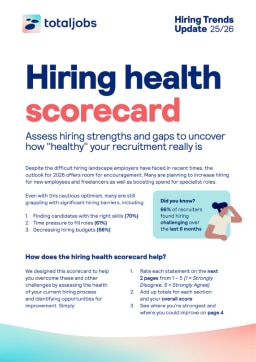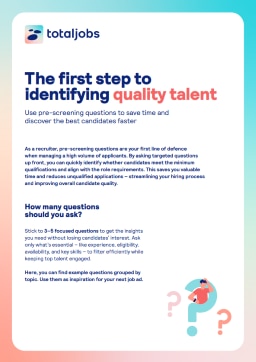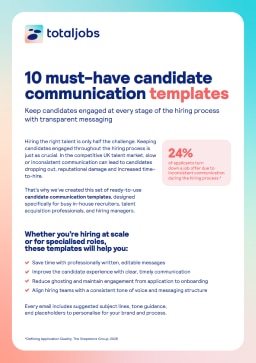
Reduce time to hire now, or risk losing top candidates
Table of Contents
- Why speedy hiring is vital
- 6 tips to speed up hiring
- A roadmap for faster hiring
- FAQs
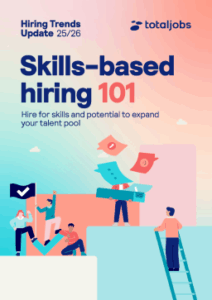
Skills Based Hiring Template
A slow hiring process can hurt more than just timelines. It can mean missing out on qualified candidates. In today’s competitive market, employers must focus on speed without sacrificing quality.
In this article, we share six effective strategies, backed by our research, to accelerate your recruitment process and unlock the full benefits of reducing time to hire.
Why a speedy hiring process is vital
The time it takes to fill a vacancy can significantly affect an organisation’s performance, with a slow hiring process leading to missed opportunities and operational disruption. Conversely, the benefits of reducing time to hire include greater efficiency, improved candidate experience, and a competitive edge.
Prolonged recruitment delays can lead to:
- Lost talent: With half of UK workers declining a job offer due to a long hiring process, delays can result in losing top candidates to other competitors.
- Reduced productivity: Open vacancies can lower overall team productivity as existing employees take on additional work, disrupting day-to-day operations.
- Reduced morale: Prolonged vacancies have an impact on employee morale, especially if existing staff are overburdened by their workload or if believe their employer to be disorganised or unresponsive.
- Increased costs: The longer recruitment takes, the more it costs in terms of advertising on job boards, agency fees, and hiring temporary staff.
- Competitive disadvantage: With the average jobseeker receiving multiple job opportunities, a slow hiring process can give competitors an advantage in securing top talent.
But there are also clear benefits of reducing time to hire, such as:
- Attracting top talent: A quicker hiring process helps employers secure the best candidates before they accept offers elsewhere, providing a competitive advantage in a tight job market.
- Improved candidate experience: Speedy decisions and a streamlined process enhance the candidate experience, reducing frustration and dropout rates.
- Enhanced employer brand: Efficient recruitment reflects positively on employers, showcasing them as an attractive and responsive employer to potential hires.`
- Improved retention: For those already on the books, seeing that their employer is ready to step up and fill gaps that make their life easier can make a world of difference to their loyalty and commitment.
- Smoother onboarding: A quicker hiring process allows new hires to start sooner and potentially overlap with departing employees, providing a more seamless onboarding experience and faster integration into the team.
6 strategies to speed up the hiring process
Let’s take a look at 6 of the best practices you can implement to ensure a quicker, more efficient recruitment process.
1. Audit current hiring timelines
Before trying to speed up hiring, it’s first vital to determine where things are being held up.
A good place to start is mapping out current recruitment stages, for example, job posting, CV screening, interviews, feedback collection, and offer generation. Once this is complete, assign approximate durations to each.
Our research shows that a typical UK hiring process averages around 4.9 weeks, but recruiters report losing 17.7 hours per vacancy to manual tasks alone. Identifying bottlenecks, like waiting for feedback or manual scheduling, makes it easier to tackle the right areas.

Tip: Use analytics to measure:
- Average time from application to interview
- Interview-to-offer time
- Offer acceptance lag
Compare these against industry benchmarks to pinpoint inefficiencies.
2. Automate repetitive tasks
Hiring teams are often overwhelmed by admin work. According to our findings, on average, recruiters spend:
- 3.6 hours per vacancy reviewing applications
- 2.5 hours scheduling interviews
- 3 hours updating candidate profiles post-interview
- 3.1 hours on data entry in HR systems
Combined, that comes to more than two days per vacancy spent on tasks that can actually be automated.
As a result, in order to speed up the hiring process, employers and hiring managers should consider automation tools or features that can:
- Auto-screen CVs based on job criteria
- Schedule interviews based on availability
- Trigger automatic status updates to candidates
- Create templated follow-up emails and rejections
In fact, many have already started this process. 77% of recruiters say AI tools are improving hiring efficiency. Specifically, they are using AI to:
- Write and publish job ads (27%)
- Review CVs (25%)
- Conduct post-interview processing (17%)
- Provide feedback or send offers (17%)
Streamlining these tasks saves time, reduces errors, and improves the candidate experience.
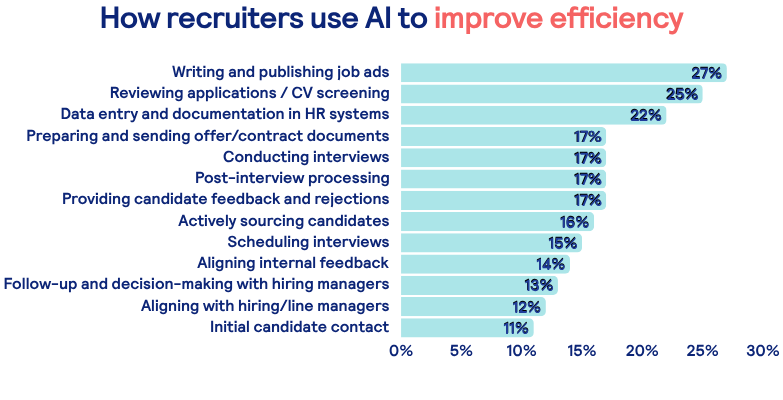
3. Focus on high-quality sourcing channels
A key factor in reducing time to hire is homing in on the sourcing channels that yield the best results.
We found that the channels recruiters’ rate as the most effective include:
- Paid job listings: 70% overall, 73% for large businesses
- Company careers pages: 71% for large firms
- Employee referral programmes: 68%
- Upskilling partnerships (e.g., bootcamps): 71% of SMEs found success here
So, instead of spreading budget across underperforming channels, it’s important to double down on those delivering quality and speed.
This can be achieved by measuring:
- Time to qualified applicant by source
- Number of interview-worthy candidates per platform
- Offer-to-acceptance rates per source
Once this has been calculated, you can then build a sourcing mix that prioritises speed and fit, thereby helping to speed up hiring without sacrificing quality.
4. Pre-screen candidates more effectively
The typical recruiter receives around 20 applications per vacancy. However, our research shows that just 50% of those applicants are qualified for the role. The result is a lot of wasted screening time.
There are a number ways to reduce the time spent on screening, such as:
- Adding knockout questions to job applications (e.g., “Do you have X years’ experience in Y?”)
- Using CV reviewing tools that highlight must-have skills
- Including salary range and job expectations clearly in the ad

Tip: Clarity is crucial. 30% of candidates drop out because the role didn’t match their expectations, and 21% cited unclear job descriptions. As a result, setting the right expectations from the start helps to avoid delays later down the line.
6. Keep candidates engaged
Candidate communication can often fall through the cracks during long hiring cycles.
We found that as many as 28% of candidates ultimately drop out, and 1 in 4 (25%) say it’s because the process took too long. Others cited factors such as:
- Poor communication (23%)
- Lack of role clarity (21%)
- No transparency about timelines or salary
Keeping candidates engaged throughout is central to ensuring they stay in the process as long as possible. This can be achieved by:
- Letting candidates know what to expect at each stage
- Providing feedback promptly
- Sharing timelines (even if it’s “you’ll hear back in 3 days”)
- Consider implementing application status trackers (something supported by 77% of candidates)
A roadmap for faster hiring
In summary, speeding up hiring doesn’t require cutting corners. It’s about cutting waste. By automating admin, improving internal coordination, and engaging candidates better, you can fill roles faster with high-quality candidates.
Frequently asked questions (FAQs)
How can I identify what’s slowing down our hiring process?
Start by auditing your current hiring timeline. Map out each recruitment stage (job posting, CV screening, interviews, etc.) and assign time durations to each. Look for bottlenecks like delayed feedback or excessive manual admin to target for improvement.
What are the most effective ways to speed up the hiring process?
Key strategies include auditing timelines, automating repetitive tasks, focusing on high-performing sourcing channels, improving candidate pre-screening, speeding up stakeholder feedback, and keeping candidates engaged throughout.
How does automation help speed up the hiring process?
Automation tools can handle tasks like CV screening, interview scheduling, candidate status updates, and follow-up emails, freeing up recruiters’ time and eliminating delays caused by manual processes.
Why do candidates drop out of slow hiring processes?
Many drop out due to long wait times, poor communication, unclear job roles, or lack of transparency. To reduce dropouts, keep candidates informed, offer timelines, and provide regular updates.
Can speeding up hiring hurt candidate quality?
Not necessarily. When done right, faster hiring improves efficiency without sacrificing quality. The key is reducing waste, not cutting corners, which can be achieved by automating low-value tasks, improving clarity, and maintaining a strong candidate experience.
Receive the latest recruitment resources and
advice to boost your hiring
By providing us with your details you agree to our privacy policy and for us to keep you updated with the latest news, events,
and special offers from Totaljobs.



